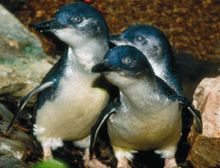Description: The Blue penguin (named for its blue upperparts) is sometimes called the Little blue penguin (named for its small size). Eudyptula” is Greek for “good little diver.” The underbelly is white; iris is gray-white; and the bill is gray-black and pinkish at the lower base.
Size: Eudyptula minors are the smallest of all penguin species. They are 16-17 inches (41-43 cm) tall and weigh about two pounds (0.91kg). Both sexes are alike, but the males may be somewhat heavier and the bill is usually larger.
Behavior: Like all species of penguins, they are highly adapted for life in the sea. The feathers are dense, modified wings are used as flippers; tail is used for steering; the body is streamlined to glide through the water. Most adults are sedentary, remaining with the colony when not at sea. Adults forage at sea from dawn to almost dusk. They feed singly, not as a cooperative group. They often travel 8.7-12.4 miles (14-20 km) daily when searching for food, but travel less when breeding. They can dive to 226 feet (69 m), but average approximately 98 feet (30 m). Blue penguins remain offshore until dusk, at which time they cross the beach in tight groups and head to their own burrows.
Diet: Their diet is comprised of marine animals, cephalopods, crustaceans, small fish (anchovies, squid, plankton, krill, seahorses, etc.).
Senses: Hearing is thought to be good, but not as good as that of marine mammals. The eyes are adapted for seeing underwater. The olfactory lobe of the penguin’s brain is large, indicating their sense of smell may be quite developed.
Communication: Fairy penguins are quite vocal and make a variety of calls for various situations. A “croon- like” call announces their territory at their burrow, “brays” often advertise for mates or to signal territory and “barks” are more common at sea
Reproduction: Most breeding pairs live in colonies, although some choose to nest on their own. Both parents dig the burrow, with the male often contributing more than the female. The burrow is often dug in sand or other soft soil (an average of 16 inches or 41 cm long) and grass is collected for lining the nest. In some areas, they may nest in crevices or caves in the rocks. The normal clutch is two white eggs which are incubated by both parents for 33-35 days. The nesting period is between 54-63 days, with both parents tending the chicks. Within a few days after hatching, parents alternate, with one guarding the nest while the other forages for food. Chicks are fed regurgitated food. After two weeks, both parents forage for food each day, returning in the evening to feed the chicks. After approximately eight weeks, young fledglings are forced from the nest to fend for themselves. Fairy penguins are monogamous and usually return to the same colony each year, but often to different burrows. Parents actively defend their burrows, resulting in aggression such as posturing and calling, to slapping with flippers, pecking and shoving.
Habitat/range: Fairy penguins are found in the Southern Hemisphere in the waters of New Zealand and southern Australia. They live in waters that range between 55-68 degrees F (13-20 degrees C).
Status: Although not globally threatened, they face many threats to their survival – predators at sea (sharks, Killer whales and seals), and predators on land (eagles, gulls, feral cats foxes and dogs). Lizards and snakes also prey upon eggs and hatchlings. Man-made obstacles are plastic, road kills, fishing with nets, oil spills, plastic and loss of habitat.They are classified as Least Concern on the IUCN; CITES no special status. Included in AZA Species Survival Plan® (SSP). This
program cooperatively manages specific, and typically threatened or endangered populations.



